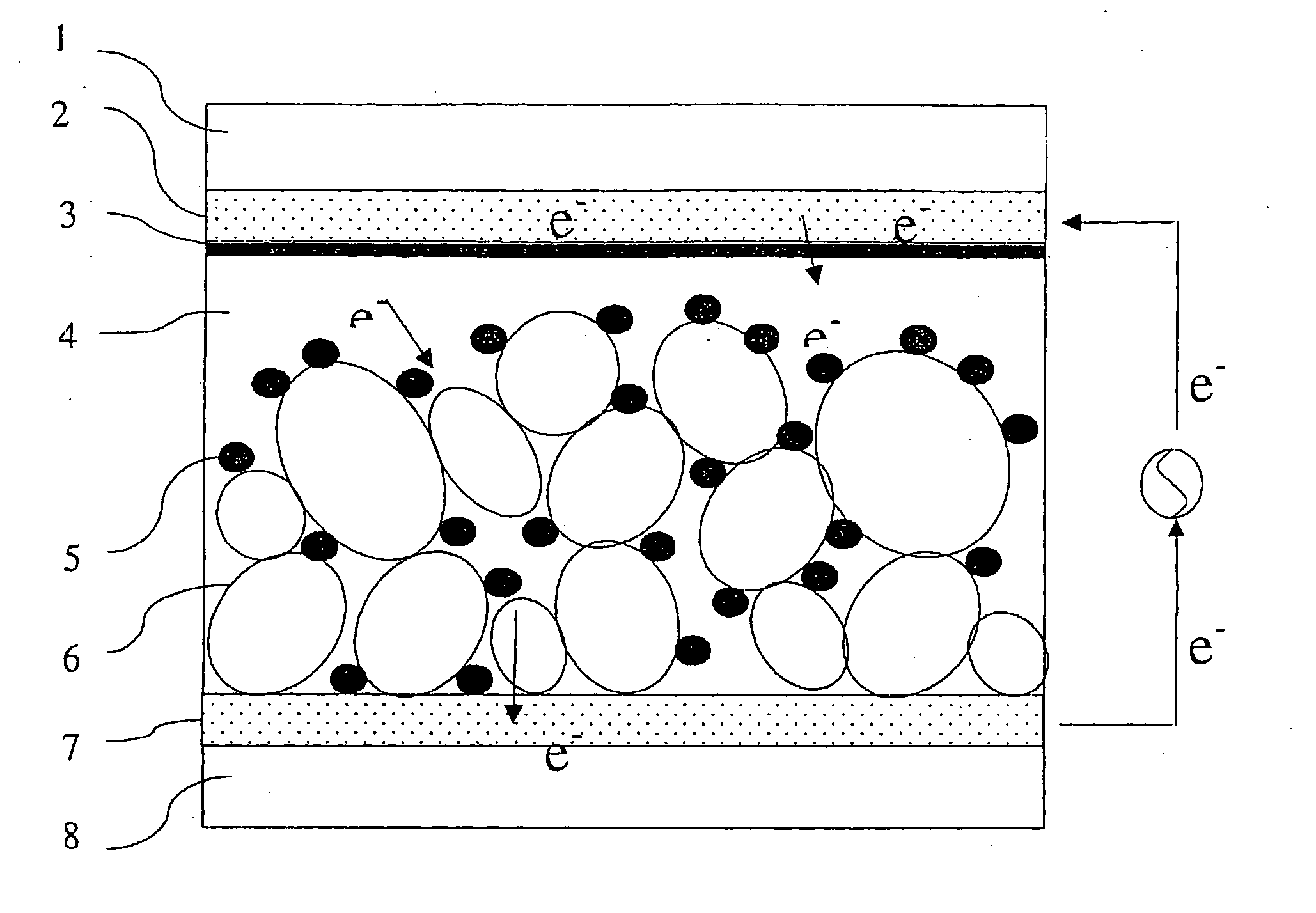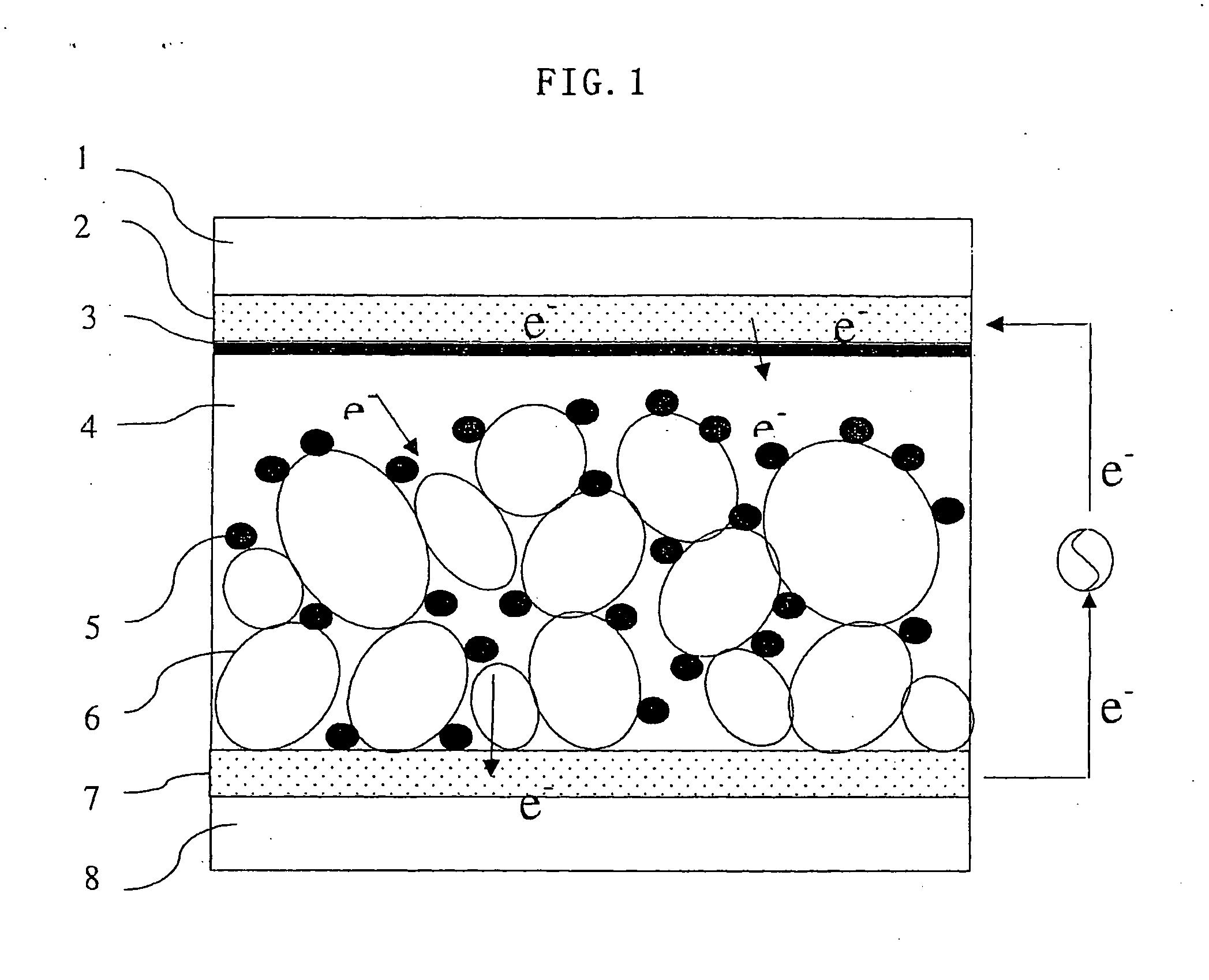Dye-sensitized solar cell
- Summary
- Abstract
- Description
- Claims
- Application Information
AI Technical Summary
Benefits of technology
Problems solved by technology
Method used
Image
Examples
examples
[0074] The invention will be described in more detail with reference to the following examples; however, the invention is not limited to the examples.
[0075] Heterocyclic Compound (A)
examples a-1 to a-8
and Comparative Examples 1 to 7
[0076] Using electrolytic solutions containing the heterocyclic compounds in Table 1 in the concentrations shown in the table, dye-sensitized solar cells were manufactured as follows.
TABLE 1No.Heterocyclic compound% By volume*Example A-1Tetrahydrofuran10Example A-2Tetrahydrofuran40Example A-32-Methyl-tetrahydrofuran30Example A-4Pyran20Example A-5Pyran40Example A-6Tetrahydropyran20Example A-7Furan5Example A-82-Methyl-furan20Comp. Ex. 1Tetrahydrofuran70Comp. Ex. 2Pyran70Comp. Ex. 3Tetrahydropyran70Comp. Ex. 41,4-Dioxane90Comp. Ex. 5Trioxane90Comp. Ex. 6Furan70Comp. Ex. 7Not added
*Remainder is a mixture of acetonitrile, DMPII, lithium iodide, iodide and TBP.
[0077] Formation of a Porous Semiconductor Layer
[0078] First, a commercially available titanium oxide paste (trade name: Ti-Nanoxide D, average particle diameter: 13 nm, made by Solaronix Co., Swiss) was applied by a doctor blade method to a transparent conductive film of SnO2 formed by vapor depos...
examples b-1 to b-10
[0089] Dye-sensitized solar cells were manufactured in the same manner as in Examples A-1 to A-8 except that the heterocyclic compounds in Table 3 were contained in the electrolytic solutions in the concentrations shown in the table.
TABLE 3No.Heterocyclic compound% By volumeExample B-14-Methyl-1,3-dioxolane20Example B-21,3-Dioxolane20Example B-31,3-Dioxane40Example B-41,4-Dixoane5Example B-51,4-Dixoane30Example B-62H-1,3-Dioxole60Example B-73H-1,2-Dioxole55Example B-8Dioxene70Example B-91,4-Dioxin20Example B-10Trioxane5Comp. Ex. 7Not added
[0090] The photoelectric conversion efficiencies of the dye-sensitized solar cells thus obtained were evaluated in the same manner as in Examples A-1 to A-8. The results are shown in Table 4.
TABLE 4No.Jsc (mA / cm2)Voc (V)FFEffi. (%)Example B-116.50.7550.7108.84Example B-216.80.7560.7279.23Example B-317.90.7550.7099.58Example B-418.10.7340.7349.75Example B-517.80.7660.7219.83Example B-616.40.7820.7119.12Example B-716.50.7790.7129.15Example B-816....
PUM
 Login to View More
Login to View More Abstract
Description
Claims
Application Information
 Login to View More
Login to View More - R&D Engineer
- R&D Manager
- IP Professional
- Industry Leading Data Capabilities
- Powerful AI technology
- Patent DNA Extraction
Browse by: Latest US Patents, China's latest patents, Technical Efficacy Thesaurus, Application Domain, Technology Topic, Popular Technical Reports.
© 2024 PatSnap. All rights reserved.Legal|Privacy policy|Modern Slavery Act Transparency Statement|Sitemap|About US| Contact US: help@patsnap.com










